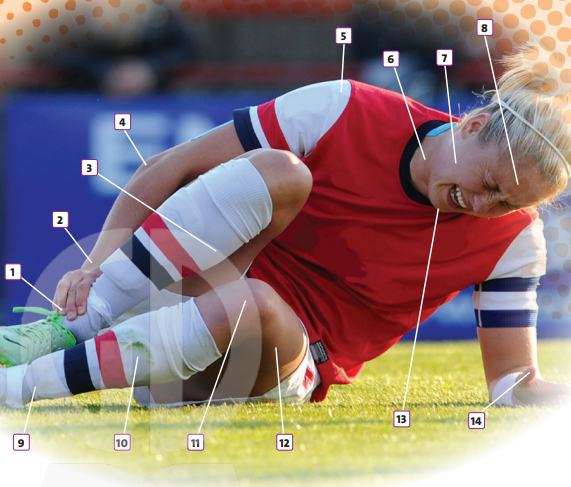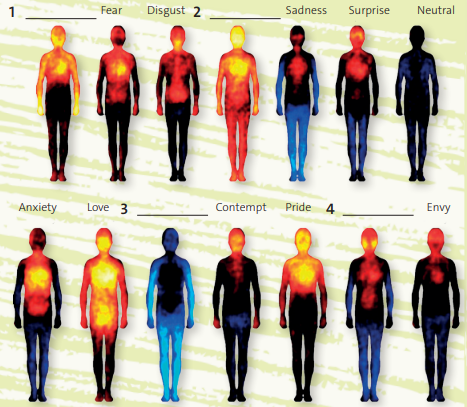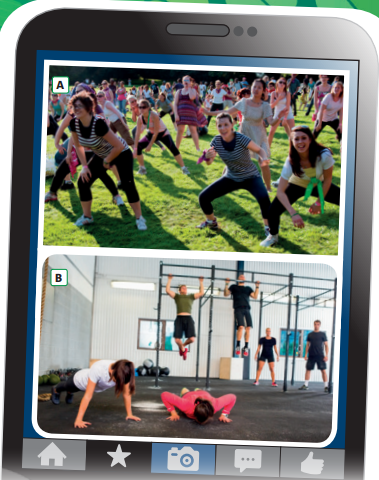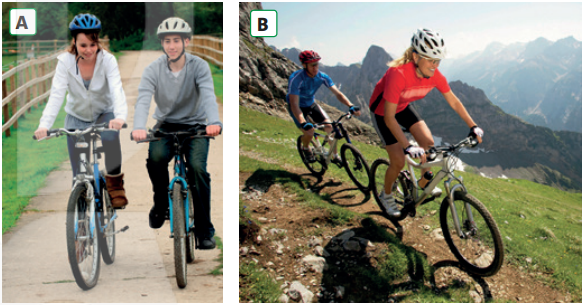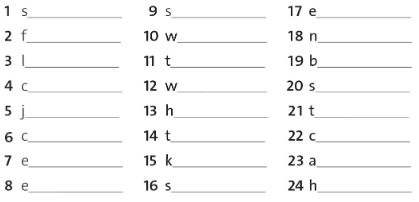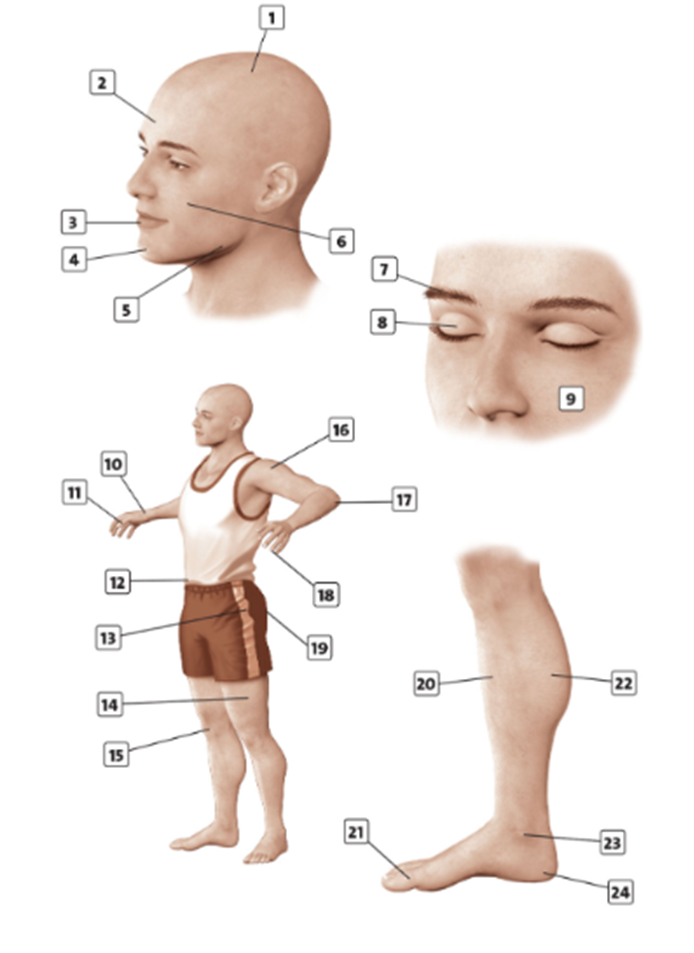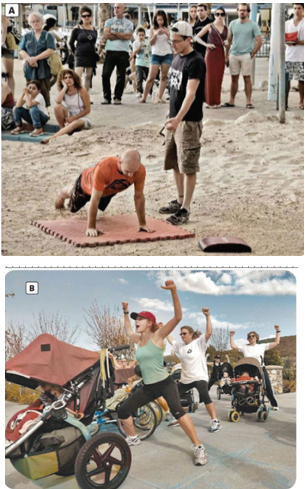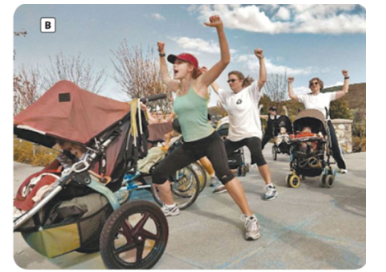Giải SGK, SBT Unit 3. Sustainable health Friends Global
Giải SGK, SBT Unit 3 Friends Global
2. VOCABULARY Match 1-14 in the photo with parts of the body from the list below. Check the meaning of all the words in the list.
(Ghép 1-14 trong ảnh với các bộ phận của cơ thể từ danh sách bên dưới. Kiểm tra ý nghĩa của tất cả các từ trong danh sách.)
Parts of the body
|
ankle |
blood |
bottom |
brain |
calf |
cheek |
|
chin |
elbow |
eyebrow |
eyelid |
forehead |
heart |
|
heel |
hip |
intestine |
jaw |
kidney |
knee |
|
lung |
muscle |
nail |
neck |
rib |
scalp |
|
shin |
shoulder |
skin |
skull |
spine |
stomach |
|
thigh |
throat |
thumb |
toe |
waist |
wrist |
5. VOCABULARY Listen to three dialogues between doctors and their patients. Complete the table using the words below to complete the treatments.
(Nghe ba cuộc đối thoại giữa các bác sĩ và bệnh nhân của họ. Hoàn thành bảng sử dụng các từ dưới đây để hoàn thành các phương pháp điều trị.)
Treatments (Sự chữa trị)
|
- antibiotics: kháng sinh - bandage: băng bó - cream: kem - dressing: băng |
- medicine: thuốc - painkillers: thuốc giảm đau - X-ray: tia X |
|
Patient (Bệnh nhân) |
1 |
2 |
3 |
|
Part of the body injured (Bộ phận cơ thể bị thương) |
|
|
|
|
When (Khi nào) |
|
|
|
|
Treatment (Sự chữa trị) |
|
|
|
6 Read the Recycle! box. Complete the extracts from the dialogues with the verbs in brackets. Use the present perfect or past simple. Listen again and check your answers.
(Đọc khung Recycle! Hoàn thành các đoạn trích từ các cuộc đối thoại với các động từ trong ngoặc. Sử dụng thì hiện tại hoàn thành hoặc quá khứ đơn. Nghe lại và kiểm tra câu trả lời của bạn.)
Dialogue 1
a My ankle really hurts. I think I__________ (twist) it.
b Yes, it's a bit swollen. You__________(sprain) it.
Dialogue 2
c I __________ (have) an accident. I__________ (bang) my head.
d I__________ (trip) over the cat and__________ (hit) my head on the corner of a table.
Dialogue 3
e I__________ (hurt) my thumb. I __________ (trap) it in the car door.
f You __________ certainly __________ (bruise) it.
g It's really painful. Do you think I __________ (break) it?
|
RECYCLE! Present perfect and past simple (RECYCLE! Hiện tại hoàn thành và quá khứ đơn) a. We use the present perfect for: (Chúng ta sử dụng thì hiện tại hoàn thành cho) 1. giving news, when we do not say exactly when the event happened. (đưa ra tin tức, khi chúng ta không nói chính xác thời điểm sự kiện xảy ra.) 2. talking about experiences. (nói về kinh nghiệm.) b. When we ask for or give specific information about the news or experience, we use the past simple. (Khi chúng tôi yêu cầu hoặc cung cấp thông tin cụ thể về tin tức hoặc kinh nghiệm, chúng tôi sử dụng quá khứ đơn.) I've broken my wrist. I fell off my bike. (Tôi bị gãy cổ tay. Tôi ngã xe.) 'Have you ever broken your leg?" - "Yes, I broke my left leg last year” ('Bạn đã bao giờ bị gãy chân chưa?' - 'Có, tôi bị gãy chân trái vào năm ngoái') |
3. Match the highlighted structures in the article with rules a-d in the Learn this! box below.
(Nối các cấu trúc được đánh dấu trong bài viết với các quy tắc a-d trong khung Learn this! bên dưới.)
|
LEARN THIS! Speculating and predicting (LEARN THIS! Suy đoán và dự đoán) a We use will / won't to make predictions. (Chúng ta sử dụng will / won't để đưa ra dự đoán.) Scientists will find a cure for cancer. (Các nhà khoa học sẽ tìm ra thuốc chữa ung thư.) b We can use phrases with will / won't to make the predictions stronger or weaker. (Chúng ta có thể sử dụng các cụm từ với will / won't để làm cho các dự đoán mạnh hơn hoặc yếu hơn.) I'm (fairly) sure/I think/I don't think / I doubt scientists will find a cure for cancer. (Tôi (khá) chắc chắn/tôi nghĩ/tôi không nghĩ/tôi nghi ngờ các nhà khoa học sẽ tìm ra cách chữa trị bệnh ung thư.) Scientists will definitely / probably find a cure for cancer. (Các nhà khoa học chắc chắn/có thể sẽ tìm ra cách chữa trị bệnh ung thư.) c We use may / might / could + infinitive without to to talk about possibility in the future. (Chúng ta dùng may/might/could + infinitive without to để nói về khả năng xảy ra trong tương lai.) Scientists may / might/could find a cure for cancer. (Các nhà khoa học có thể/có thể/có thể tìm ra cách chữa trị bệnh ung thư.) d We use may not / might not for the negative. We do not use could not. (Chúng ta dùng may not / might not cho câu phủ định. Chúng ta không dùng could not.) |
5. Study the examples in the Learn this! box below and complete the rules with the correct verbs and tenses.
(Nghiên cứu các ví dụ trong phần Learn this! ô bên dưới và hoàn thành các quy tắc với các động từ và thì đúng.)
|
LEARN THIS! The first conditional a We form the first conditional with the 1__________in the if clause and 2__________ / won't + infinitive without to in the main clause. If I pass all my exams, I'll go to university. b We can make predictions with the first conditional. You'll cut yourself if you aren't careful with that knife. c We can use may / 3__________ / could in the main clause to make the prediction less certain. You might cut yourself if you aren't careful. |
1. SPEAKING Describe and compare the photos. What are the similarities and differences between the activities? Use the words below to help you.
(Mô tả và so sánh các bức ảnh. Những điểm tương đồng và khác biệt giữa các hoạt động là gì? Sử dụng các từ dưới đây để giúp bạn.)

|
become dehydrated |
climber |
desert |
food and water |
|
frostbite |
high altitude |
oxygen |
tent |
2. Read the Listening Strategy. Then try to say the numbers and measurements below. Listen and check.
(Đọc Chiến lược nghe. Sau đó cố gắng nói các con số và phép đo dưới đây. Nghe và kiểm tra.)
|
Large numbers: (Những con số lớn) |
4,500 100,000 250,000 2.5 million |
|
Small numbers: (Những con số nhỏ) |
0 0.6 0.04 2.08 |
|
Years: (Năm) |
1500 1535 2000 2015 2150 the 1980s |
|
Fractions: (Phân số) |
½,1/3, ¼, 1/5, 1/10, 3/8, 1 2/3 |
|
Percentages: (Phần trăm) |
50% 57% |
|
Ratios and ranges: (Tỉ lệ và phạm vi) |
2:1 10:1 aged 18-25 from 0-100 in 3.1 seconds |
|
Temperature: (Nhiệt độ) |
-40°C 0°C 5°C 15°C |
|
Listening Strategy (Chiến lược nghe) Some listening tasks may involve listening out for numbers, dates and measurements. Make sure you know how to pronounce these so that you can identify the information when you hear it. (Một số bài tập nghe có thể liên quan đến việc nghe các con số, ngày tháng và các phép đo. Đảm bảo rằng bạn biết cách phát âm những từ này để có thể xác định thông tin khi nghe.) |
3. Read the Learn this! box. Complete the examples and rules. How many more examples of each tense can you find in the article?
(Đọc khung Learn this! Hoàn thành các ví dụ và quy tắc. Bạn có thể tìm thêm bao nhiêu ví dụ về mỗi thì trong bài viết?)
|
LEARN THIS! Future perfect and future continuous a We form the future perfect with will have + past participle. By the weekend, he 1___________ left hospital. b We form the future continuous with will be + -ing form. This time next month, he 2___________ playing football again. c We use the future 3__________to talk about completed action in the future. d We use the future 4___________ to talk about an action in progress in the future. |
5. USE OF ENGLISH Read the Learn this! box. Add two more time expressions from the article in exercise 2.
(Đọc khung Learn this! Thêm hai cụm từ chỉ thời gian nữa từ bài đọc trong bài tập 2.)
|
LEARN THIS! Future time expressions (LEARN THIS! Biểu diễn thời gian trong tương lai) When we talk about the distant future, we can say: (Khi chúng ta nói về tương lai xa, chúng ta có thể nói)
(khoảng 100 năm nữa)
(trong thời gian 1.000/10.000/một triệu năm)
(trong vòng 10/50/100 năm)
(vào cuối thập kỷ/thế kỷ/thế kỷ tới/thiên niên kỷ)
(trong tương lai gần / trong dài hạn) |
1. VOCABULARY In pairs, read the adjectives below and talk about situations in which you experience those feelings.
(Theo cặp, đọc các tính từ dưới đây và nói về những tình huống mà bạn trải qua những cảm xúc đó.)
Adjectives to describe feelings
|
afraid |
anxious |
ashamed |
cross |
|
disgusted |
envious |
proud |
|
I sometimes feel afraid if I see a very large spider.
(Đôi khi tôi cảm thấy sợ nếu nhìn thấy một con nhện rất lớn.)
3. Complete the tables with words from exercises 1 and 2.
(Hoàn thành các bảng với các từ từ bài tập 1 và 2.)
|
Noun |
Adjective |
|
1________ |
angry |
|
anxiety |
2________ |
|
3________ |
ashamed |
|
4________ |
envious |
|
5________ |
happy |
|
pride |
6________ |
|
7________ |
sad |
|
8________ |
surprised |
4. Read the Learn this! box. In pairs, write down two more examples for each rule (a-d). Use a dictionary to help you if necessary.
(Đọc khung Learn this! Theo cặp, viết thêm hai ví dụ cho mỗi quy tắc (a-d). Sử dụng một từ điển để giúp bạn nếu cần thiết.)
|
LEARN THIS! Word families (Gia đình từ) a Some nouns are formed by adding a suffix like -ness or -ment to an adjective. (Một số danh từ được thành lập bằng cách thêm một hậu tố như -ness hoặc -ment vào một tính từ.) sad - sadness (buồn – nỗi buồn) content – contentment (hài lòng – sự hài lòng) b Common adjective endings are -ed, -ing, -ous, -ful, -less, -y and -al. (Các đuôi tính từ phổ biến là -ed, -ing, -ous, -ful, -less, -y và -al.) surprised/surprising (ngạc nhiên) suspicious (nghi ngờ) hopeful/hopeless (đầy hi vọng/ vô vọng) dirty (bẩn) political (thuộc về chính trị) c Most adverbs are formed by adding-ly to an adjective. (Hầu hết các trạng từ được thành lập bằng cách thêm ly vào tính từ.) cross – crossly (tức giận) happy – happily (hạnh phúc) d We can change the meaning of many adjectives and adverbs by adding a prefix. (Chúng ta có thể thay đổi ý nghĩa của nhiều tính từ và trạng từ bằng cách thêm tiền tố.) surprisingly – unsurprisingly (một cách ngạc nhiên – một cách không ngạc nhiên) |
2. Read the Reading Strategy. Then read the article to get an idea of the general meaning. Which is the best summary: a, b, c or d?
(Đọc Chiến lược đọc. Sau đó đọc bài viết để có ý tưởng về ý nghĩa chung. Đâu là tóm tắt tốt nhất: a, b, c hoặc d?)
The writer's main purpose is to explain
(Mục đích chính của nhà văn là để giải thích)
a why children need more sleep than adults.
(tại sao trẻ em cần ngủ nhiều hơn người lớn.)
b why we should always get lots of sleep.
(tại sao chúng ta nên luôn luôn ngủ nhiều.)
c why our bodies feel more or less tired at different times of day.
(tại sao cơ thể chúng ta cảm thấy mệt mỏi nhiều hơn hoặc ít hơn vào những thời điểm khác nhau trong ngày.)
d why some people feel more alert than others.
(tại sao một số người cảm thấy tỉnh táo hơn những người khác.)
|
Reading Strategy (Chiến lược đọc) When matching questions with texts, follow these steps: (Khi nối câu hỏi với văn bản, hãy làm theo các bước sau) 1 Read the text to get a general idea of the meaning. (Đọc văn bản để có được một ý tưởng chung về ý nghĩa.) 2 Read the task's lead-in line very carefully (In which period of the day...). Then read all the options carefully. (Đọc kỹ phần mở đầu của nhiệm vụ (Vào khoảng thời gian nào trong ngày...). Sau đó đọc tất cả các lựa chọn một cách cẩn thận.) 3 Read the paragraphs of the text carefully one by one and match them to the correct option. (Đọc kỹ từng đoạn văn và nối chúng với phương án đúng.) 4 If you can't find the answer, leave it for now and come back to it later. (Nếu bạn không thể tìm thấy câu trả lời, hãy tạm dừng và quay lại sau.) |
HOW MUCH SLEEP DO WE NEED?
Young children need more sleep than adults and tend to wake up earlier. A typical ten-year-old needs about ten hours' sleep.
As you reach adolescence, your body clock changes. Most teenagers need about nine hours' sleep, but wake up later.
As an adult, you'll need about eight to eight and a half hours' sleep a night.
When we are much older, in our 70s and 80s, we're less able to sleep deeply and we usually need less sleep.
OUR PERSONAL BODY CLOCK
Each of us has our own personal body clock, which makes us more alert in the morning or more alert in the evening. You might be a 'lark' who likes to go to bed early and get up early, or you might be an 'owl' who prefers to go to bed late and get up late. Or somewhere in between.
A. 6AM-9A.M. Your body is waking up. It stops producing melatonin, the hormone which makes you feel sleepy. Blood vessels are stiffer and less flexible. Your blood is thicker and stickier s and your blood pressure is at its highest, so it's not the best time to exercise.
B. 9AM-12P.M. You're at your most alert at this time in the morning. Tests show that short-term memory is at its best right now.
C. 12 P.M.-3 P.M. Your stomach is full and working hard after lunch. You become much less alert and probably feel a bit sleepy. More road accidents happen at this time of day than at any other, particularly involving older 15 people.
D. 3P.M.-6PM. This is a very good time to exercise. Body temperature increases in the late afternoon. Your heart and lungs work better and muscles are six per cent stronger than at their lowest point in the day. Some sportspeople believe that if you try to break a world record at this time of day, you'll have a greater chance of success.
E. 6PM-9PM. By now you'll be getting hungry. But don't eat too late! In the evening, our bodies struggle to digest fats and sugars. Studies show that people will lose more weight if they have their main meal at lunchtime rather than in the evening. (But how much you eat is always more important than when you eat.)
F. 9PM-12AM. It's getting near to bedtime. Your body temperature is falling and your body clock is telling you that it's time for bed. Your body is producing lots of melatonin to help you go to sleep. It can o be difficult to sleep with the light on because light reduces the amount of melatonin in your body. Blue light is particularly effective at keeping us awake. And mobile phones, computer screens and flat-screen TVs emit large s amounts of blue light. So, turn off those gadgets!
G. 0A.M. - 3A.M. Your body really wants to be asleep. Melatonin reaches its maximum level. Your stomach has stopped working and your brain is at rest.
H. 3A.M.-6A.M. Melatonin levels are still high, and you are in deep sleep. Your body temperature is much cooler than at any other time of the day.
2. Read the Speaking Strategy. Then listen to two students describing the photos in exercise 1. Which student follows the strategy better? Explain your answer.
(Đọc Chiến lược nói. Sau đó lắng nghe hai học sinh mô tả các bức ảnh trong bài tập 1. Học sinh nào làm theo chiến lược tốt hơn? Giải thich câu trả lời của bạn.)
|
Speaking Strategy (Chiến lược nói) Try to give your photo description a simple structure: (Cố gắng cung cấp cho phần mô tả ảnh của bạn một cấu trúc đơn giản) 1 Say what the photo shows in general. If you are unsure, use phrases like 'It looks to me as if ..., or 'The photo appears to show .... (Nói chung những gì bức ảnh thể hiện. Nếu bạn không chắc chắn, hãy sử dụng các cụm từ như "Tôi thấy như thể ..., hoặc" Bức ảnh dường như cho thấy ....) 2 Talk about some of the interesting details in the photo. (Nói về một số chi tiết thú vị trong bức ảnh.) 3 Add a personal opinion or reaction. (Thêm ý kiến cá nhân hoặc phản ứng.) |
3. KEY PHRASES Look at the useful phrases below. Are you more likely to use them for general or detailed descriptions?
(Nhìn vào các cụm từ hữu ích dưới đây. Bạn có nhiều khả năng sử dụng chúng cho các mô tả chung hoặc chi tiết không?)
|
Identifying people in photos (Nhận dạng người trong ảnh) |
||
|
The man/ woman/ with boy/girl (Người đàn ông/phụ nữ/với chàng trai/cô gái)
|
wearing/in/with (mặc) |
purple leggings (quần leggings màu tím) a red top (áo đỏ) casual / smart clothes (quần áo bình thường / trang trọng)
|
|
with (với) |
a beard/ a moustache (râu / ria mép) his/her foot in the air (chân của anh ấy / cô ấy trong không khí) his/her hands on his/her hips (tay của anh ấy / cô ấy trên hông của anh ấy / cô ấy) bare feet (chân trần) |
|
|
who is (người mà đang) |
jumping/crouching/walking/ holding (some weights) on the ground (nhảy/cúi người/đi bộ/cầm (một số quả tạ) trên mặt đất) |
|
4. Read the Writing Strategy. Does the writer follow all of the advice? Give examples.
(Đọc Chiến lược viết. Người viết có làm theo tất cả các lời khuyên không? Cho ví dụ.)
|
Writing Strategy (Chiến lược viết) 1. Divide your essay into an introduction, main body and conclusion. (Chia bài luận của bạn thành phần giới thiệu, thân bài và kết luận.) 2. If the task has more than one element, deal with them in different paragraphs within the main body. (Nếu bài tập có nhiều hơn một yếu tố, hãy xử lý chúng trong các đoạn khác nhau trong phần chính.) 3. Use formal language. (Sử dụng ngôn ngữ trang trọng.) 4. Support opinions with evidence or examples. (Bổ sung ý kiến với bằng chứng hoặc ví dụ.) |
5. KEY PHRASES Complete the useful phrases with the words below and find them in the text in exercise 3.
(Hoàn thành các cụm từ hữu ích với các từ dưới đây và tìm chúng trong văn bản ở bài tập 3.)
|
common |
conclusion |
view |
opinion |
propose |
|
said |
see |
seems |
solution |
|
|
sum |
What |
widely |
would |
|
1 Introducing your opinions
I (strongly) believe that
In my 1___________ / 2___________
It 3___________ to me that
As I 4___________,
2 Introducing other people's opinions
It is a 5___________ held view that
It is often 6___________ that
It is a 7___________ belief that
3 Making an additional point
8___________is more,
Moreover,
Furthermore,
4 Introducing proposals and solutions
One 9___________ might be to
What 10___________ (instead) is that
I 11___________strongly recommend that
5 Concluding
To 12___________up,
In 13___________,
To conclude,
2. Complete the accidents and injuries with the verbs below.
(Hoàn thành các vụ tai nạn và thương tích bằng các động từ dưới đây.)
|
bang |
break |
bruise |
burn |
cut |
|
have |
have |
sprain |
twist |
|
1 ___________ your ankle
2 ___________ your wrist
3 ___________ a bone
4 ___________ yourself
5 ___________ a bad nosebleed
6 ___________ a black eye
7 ___________ yourself
8 ___________ yourself
9 ___________ your head
3. Match the words below with the definitions.
(Nối các từ dưới đây với các định nghĩa.)
|
blood |
brain |
heart |
intestine |
|
kidneys |
lungs |
muscle |
ribs |
|
skull |
spine |
stomach |
throat |
1 You use it to think. _____________
2 It allows you to move a part of your body. _____________
3 It's made of bone and it runs down your back. _____________
4 The red liquid in your body. _____________
5 It's a bone that surrounds your brain. _____________
6 The part of the neck where food and air go. _____________
7 It's in your chest and it pumps blood around your body. _____________
8 When you eat, the food goes down your throat to this place. _____________
9 They're in your chest. You use them to breathe. _____________
10 They are bones that go round your chest and protect your heart and lungs. _____________
11 The long tube below your stomach that digests food and gets rid of waste. _____________
12 They clean your blood. _____________


